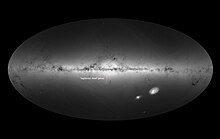Sagittarius dwarf galaxy
| Galaxy data from Sagittarius dwarf galaxy |
|
|---|---|

|
|
| The globular cluster Messier 54 belonging to the Sagittarius dwarf galaxy (Source: NASA, ESA, and The Hubble Heritage Team (STScI / AURA)) | |
| AladinLite | |
| Constellation | Sagittarius |
|
Position equinox : J2000.0 , epoch : J2000.0 |
|
| Right ascension | 18 h 55 m 19.5 s |
| declination | −30 ° 32 ′ 43 ″ |
| Appearance | |
| Morphological type | dSph (t) |
| Angular expansion | 450 ′ × 216 ′ |
| Physical data | |
| Affiliation | Local group |
| Redshift | 467 · 10 −6 |
| Radial velocity | 140 km / s |
| distance | 70,000 ly |
| history | |
| discovery | R. Ibata M. Irwin G. Gilmore |
| Discovery date | 1994 |
| Catalog names | |
The elliptical Sagittarius dwarf galaxy (also SagDEG , for Sagittarius Dwarf Elliptical Galaxy ) is a small neighboring galaxy to the Milky Way . At a distance of only 70,000 light years from our solar system , i.e. almost half the distance to the Magellanic Clouds , it is the second closest galaxy outside the Milky Way after the Canis Major Dwarf Galaxy .
This galaxy was not removed with the 3.4 million light-years irregular Sagittarius dwarf galaxy ( SagDIG , for Sagittarius Dwarf Irregular Galaxy ) are confused.
Distance and location
Like the other neighboring galaxies mentioned above, the Sagittarius dwarf galaxy is a satellite of the Milky Way and orbits the center of the Milky Way in an almost polar orbit . The current distance from the center of the Milky Way is about 50,000 light years, the current position as seen from Earth is near the dense central part of the Milky Way. Accordingly, the apparent brightness of this dwarf galaxy is extremely weakened by interstellar extinction and it was therefore only discovered in 1994 . For the next ten years, the Sagittarius dwarf galaxy was considered the closest neighbor of the Milky Way, but lost this 'title' to the aforementioned Canis Major dwarf galaxy in 2003 .
The trajectory that is assumed based on the current state of research suggests that the dwarf galaxy will move through the galactic plane within the next 100 million years; the future of this galaxy is therefore uncertain, as the tidal forces of the Milky Way and the interaction with interstellar matter should cause a slow dissolution process.
Inner structure
The densest part of the Sagittarius dwarf galaxy has a diameter of about 10,000 light years and accordingly occupies an area of over 8 degrees in diameter in the sky . This part corresponds to a typical elliptical dwarf galaxy, but due to the enormous tidal forces many members have already been removed from the core and are distributed in a long band along the orbit of the galaxy. Although this dissolution process is confirmed by both numerical calculations and direct observation, some researchers believe that the dissolution process is less rapid than the calculations predict. The reason for this assumption are models according to which the dwarf galaxy has already orbited the Milky Way about ten times, and according to the theory it should not have such a coherent dense core as the one observed in this case. A possible cause of this coherence could be a large amount (in such cases often used to explain) dark matter in the center of the dwarf galaxy.
The majority of the approximately one billion stars that the Sagittarius dwarf galaxy contains belong to Population II ; That is, they are older and poor in metal, and the galaxy also contains little interstellar matter, as is typical of dwarf elliptical galaxies. Both facts suggest that the galaxy is older. There also seems to be a striking resemblance between the stars and those of the Large Magellanic Cloud. Hypotheses are based on this , according to which the Sagittarius dwarf galaxy was associated with the Magellanic Clouds in earlier times.
companion
The Sagittarius dwarf galaxy has its own globular cluster , namely Messier 54 . This bright globular star cluster has been known for over 200 years and (apparently) much brighter than the galaxy, as it is not covered by interstellar dust .
Collisions with the Milky Way
In an article published in 2020 in "Nature Astronomy", researchers use star formation regions to suggest that the dwarf galaxy has already crossed the Milky Way three times. The collisions are said to have occurred 5.7, 1.9 and 1 billion years ago. The authors also propose that during the collision 5.7 billion years ago, the mixing of the two galaxies led to the formation of our solar system.
Web links
- Sagittarius Dwarf Galaxy at solstation.com
Individual evidence
- ↑ a b c d NASA / IPAC EXTRAGALACTIC DATABASE
- ↑ The Sagittarius Dwarf Elliptical Galaxy, SagDEG
- ↑ Milky Way: Solar system could result from galactic collision. Retrieved June 4, 2020 .
- ↑ Tomás Ruiz-Lara, Carme Gallart, Edouard J. Bernard, Santi Cassisi: The recurrent impact of the Sagittarius dwarf on the star formation history of the Milky Way . In: Nature Astronomy . May 25, 2020, ISSN 2397-3366 , doi : 10.1038 / s41550-020-1097-0 ( nature.com [accessed June 4, 2020]).


